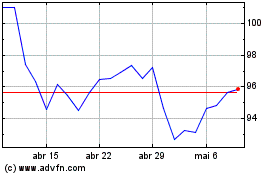Supply Cuts Boost Canadian Oil Producers
21 Julho 2020 - 6:59AM
Dow Jones News
By Vipal Monga
TORONTO -- Aggressive cuts by Canadian oil producers in the
spring are starting to pay off in the summer.
After coronavirus-related shutdowns stalled business, U.S. oil
refiners have started making more gasoline for drivers who are
returning to the road. That has increased demand for Canadian oil,
which is the largest source of crude for Midwestern refineries.
Though the recovery is still nascent and remains fragile, it is
an improvement from March.
Then, amid a global supply glut and pandemic-related slowdowns,
oil prices plunged, and companies such as Calgary-based Suncor
Energy Inc., Cenovus Energy Inc. and Husky Energy Inc. decided to
shut down wells because they had few places to sell their oil
profitably.
Canada's oil industry, the world's fourth-largest crude
producer, was hard hit by the pandemic because it is almost
entirely dependent on the U.S. as an export market. As the U.S.
economy froze, many Canadian producers eased production, cut
spending, stopped share buybacks or shaved dividends.
Now, they are sounding a more optimistic tone.
"They're coming out of the other side of this in decent shape,"
said Matt Murphy, an analyst with Tudor Pickering Holt & Co. in
Calgary. "I think in hindsight it will have been a fairly smart
decision to cut production."
Canadian producers in May cut average petroleum production by
1.3 million barrels a day more than February levels, according to
the U.S. Energy Information Administration. May's production of 4.4
million barrels a day was 20% lower than average monthly production
in 2019. It was also the lowest since mid-2016, when wildfires
burned through large portions of the Canadian oil sands and many
oil fields shut down.
The shut-in strategy has helped. A combination of rising demand
and limited supply has shrunk crude-oil inventories, which were
threatening to swamp available storage during the spring
lockdowns.
The inventory in Western Canada totaled 28.6 million barrels as
of June 26, down 214,000 from June 5, according to data provider
Genscape. At the beginning of March, inventories totaled almost 31
million barrels.
In the U.S., by contrast, supply continues to exceed demand.
Crude inventories rose slightly from May to a record 538.8 million
barrels at the end of June, according to the American Petroleum
Institute.
Refiners in the U.S. Midwest are geared toward processing the
thicker crude that Canada exports and are willing to pay up for
scarce supply, said Mr. Murphy. That is brightening Canadian
producers' outlook.
Exxon Mobil-owned Imperial Oil Ltd., which has three refineries
in Canada that supply Canadian and U.S. markets, has been
processing more gasoline and diesel fuel as economies have eased
their Covid-19-related shutdowns, said Chief Executive Brad Corson,
at a July energy conference. "If we continue on the path we're on,
I feel quite optimistic," he said.
Western Canadian Select crude oil was selling for $31.68 a
barrel on Monday, according to S&P Global Platts, $9.45 lower
than the U.S. benchmark grade West Texas Intermediate. The thicker
Canadian oil trades at a discount to the U.S. benchmark because it
is more difficult to refine and needs to travel farther to get to
market. The differential had narrowed from roughly $23 in
January.
Canadian producers pay operating costs as high as $25 a barrel,
so oil prices in the $30 range mean many are cash-flow positive and
should be bringing more production back on line, said Platts
analyst Parker Fawcett.
There are already signs of increased drilling in Canada's oil
patch. The number of oil-drilling rigs for the week ended July 17
rose by six to 32, according to oil-service company Baker Hughes.
Though the number is down 86 from the same time a year earlier, the
weekly increase suggests that demand is picking up. In the U.S., on
the other hand, the rig count fell by five in that week.
Calgary-based Cenovus, which shut in roughly 60,000 barrels a
day of production in March, has since resumed production of most of
the shut-in crude, said CEO Alex Pourbaix at a TD Securities energy
conference earlier this month.
"We are seeing a strong price signal to bring those barrels back
on," said Mr. Pourbaix.
Write to Vipal Monga at vipal.monga@wsj.com
(END) Dow Jones Newswires
July 21, 2020 05:44 ET (09:44 GMT)
Copyright (c) 2020 Dow Jones & Company, Inc.
Imperial Oil (TSX:IMO)
Gráfico Histórico do Ativo
De Mar 2024 até Abr 2024

Imperial Oil (TSX:IMO)
Gráfico Histórico do Ativo
De Abr 2023 até Abr 2024
